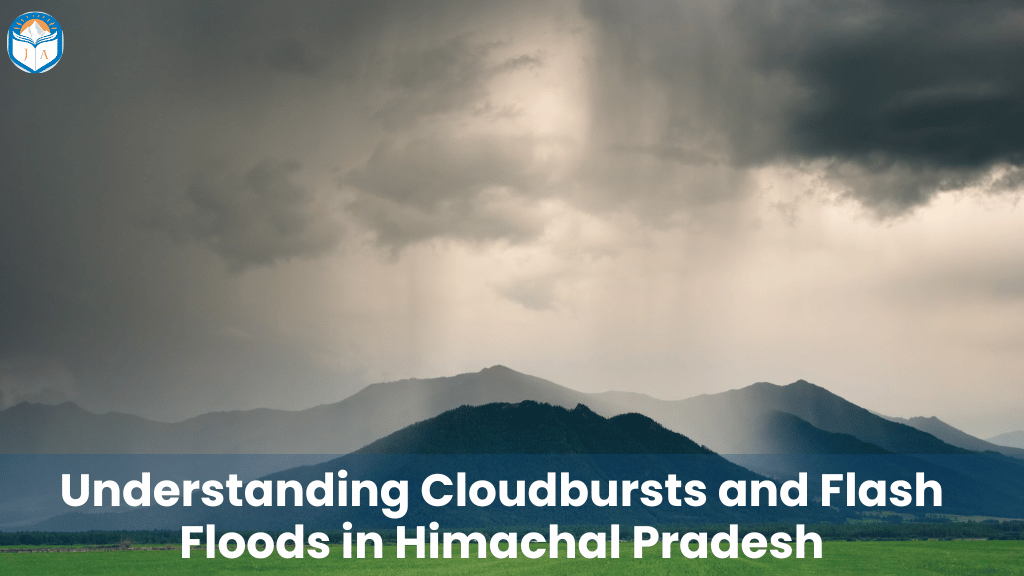Understanding Cloudbursts and Flash Floods in Himachal Pradesh: A Must-Know Topic for HAS Aspirants
Why in the News?

On June 26, 2025, multiple districts in Himachal Pradesh were battered by cloudbursts, triggering devastating flash floods. As per official reports, three bodies were recovered in Kangra, taking the death toll to five. The Kullu district was particularly affected, with cloudburst incidents recorded in Banjar, Gadsa, Manikaran, and Sainj. In response, the Himachal Pradesh Police Headquarters issued an advisory due to the heightened risks of floods, landslides, and more cloudbursts following the active monsoon conditions.
In light of these extreme weather events, it is vital to understand what cloudbursts are, how they lead to flash floods, and what broader climatic trends suggest about such phenomena.
What is a Cloudburst?
A cloudburst is an extreme weather event characterized by intense, localized rainfall in a short period. According to the India Meteorological Department (IMD), it is defined as:
Precipitation exceeding 100 mm (10 cm) per hour over an area of 20–30 square kilometers.
This concentrated deluge can trigger dangerous floods and landslides, especially in mountainous terrain. Although all cloudbursts involve heavy rainfall, not every heavy rainfall event qualifies as a cloudburst, unless it meets this intensity and scale.
Why Are Cloudbursts Difficult to Predict?
Despite advances in technology, cloudbursts remain difficult to predict due to their sudden and localized nature. While Doppler radars can give warnings up to two hours in advance, their effectiveness is limited in hilly areas where mountains obstruct radar signals.
Moreover, cloudburst-prone conditions can shift rapidly, forming in one place and quickly moving to another. This unpredictability makes it hard for meteorologists to issue timely alerts.
How Cloudbursts Lead to Flash Floods
A flash flood is a sudden, intense flood caused by heavy rainfall over a brief period. Here’s how cloudbursts cause them:
- Short duration, high intensity rainfall saturates the soil.
- In hilly areas, water rushes down steep slopes, overwhelming narrow rivers and streams.
- With no time for absorption or drainage, water collects rapidly, leading to flooding in valleys and low-lying areas.
- In many cases, flash floods are accompanied by landslides, compounding the destruction.
What is a Glacial Lake Outburst Flood (GLOF)?
In addition to cloudbursts, Himalayan states face the increasing threat of GLOFs — Glacial Lake Outburst Floods. These are disaster events triggered by the sudden release of water from glacial lakes, which are formed as glaciers melt and retreat due to rising global temperatures.
Glacial lakes may form:
- In front of a glacier (proglacial),
- On the glacier surface, or
- Underneath a glacier.
When the natural dam (usually made of loose moraine or ice) holding these lakes breaks, it can unleash enormous volumes of water, sediment, and debris downstream with immense force and speed. The resulting floods can:
- Submerge valleys,
- Destroy roads, bridges, and buildings,
- Endanger lives, and
- Devastate local economies.
Recognizing this growing threat in the age of climate change, the United Nations has declared 2025 as the International Year of Glaciers’ Preservation to promote global awareness and coordinated action to safeguard glacial ecosystems.
Why Are Cloudbursts Common in Hill States?
Three key factors contribute to frequent cloudbursts in Himachal Pradesh:
1. Wind Patterns and Moisture
Moisture-laden winds from monsoons or western disturbances collide with mountain slopes, leading to rapid cloud formation.
2. Mountain Height and Topography
Mountains block and trap clouds, forcing them to rise. As they ascend, they cool and condense rapidly, releasing heavy rainfall.
3. Air Currents and Saturated Clouds
Sometimes, rising warm air currents prevent raindrops from falling, instead pushing them upward. These drops combine and grow in size until they become too heavy, falling suddenly in a violent downpour—a typical cloudburst.
Chain Reaction: Cloudbursts → Flash Floods → Landslides
- Cloudbursts saturate the soil.
- Water accumulation and pressure result in flash floods.
- Unstable, saturated slopes give way, causing landslides.
- This sequence is devastating in mountainous areas with fragile ecosystems and human settlements close to rivers and slopes.
Climate Change and Rising Frequency
According to the State of the Climate in Asia 2024 report, climate change is amplifying extreme weather events like cloudbursts, GLOFs, and flash floods. Warming temperatures, shifting wind patterns, and increased atmospheric moisture are contributing to the growing frequency and intensity of such events, especially in the Himalayas.
The Way Forward: Preparedness & Awareness
- Enhanced Forecasting: Upgrade radar and satellite systems in mountainous regions.
- Early Warning Systems: Develop robust, real-time alert systems at local levels.
- Disaster-Resilient Infrastructure: Build and reinforce structures to withstand floods and landslides.
- Glacier Monitoring: Track glacial melt and glacial lake expansion.
- Climate Education and Action: Promote awareness and reduce carbon footprints to slow down global warming.
Conclusion
Cloudbursts and glacial lake outbursts are powerful reminders of nature’s volatility in a warming world. As seen in Himachal Pradesh, such events can claim lives, damage ecosystems, and cripple infrastructure within minutes. A scientific understanding of these events, coupled with improved preparedness, community awareness, and environmental responsibility, is essential to mitigate their impact and build a climate-resilient future for our mountain regions.


